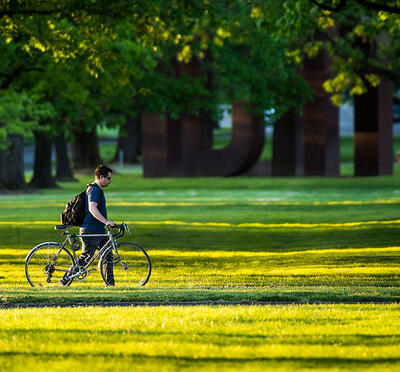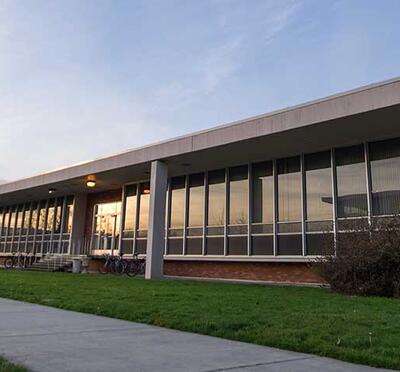Rick Robertson was barely a teenager when he started his first construction job. He dug catch basins, pushed concrete, and hauled materials through the long summer days. The hard work was nothing new.
“We all worked when we were kids,” said Robertson, B.S. civil engineering ’85, M.S. ’87. “School let out in June, you’d get a few days of vacation, then you went to work. I was picking strawberries in fourth grade.” But it was the construction sites, where he worked every summer through high school, that fascinated him — the precision of surveying, the machines that created perfectly aligned concrete curbs, the lasting contribution to something bigger than himself. “It opened my eyes to the possibilities of civil engineering; I could imagine a future doing that.”
In the meantime, Robertson indulged his more immediate passion: basketball. In 1979, his junior year at McMinnville High School, the team won 27 consecutive games and the state championship. The following season, the Grizzlies extended their unbeaten streak to 39, at the time the longest in Oregon history. The team overflowed with talent, including Robertson’s childhood friend, Charlie Sitton, a future All-American at Oregon State University. Pulling it all together was their coach, Nick Robertson, who would win 699 games over a 41-year career and earn a spot in the Oregon Sports Hall of Fame.
“More than anyone else, my father taught me about communication, teamwork, and caring for others. So much of what I learned to prepare me for life I learned from him,” Robertson said. His father, now 81, still helps out young players.
Robertson’s first year at Oregon State was a rough one, marked by the death of his younger brother, Greg. After transferring to Willamette University for a couple of years to regroup, he played for the school’s basketball team, which helped him to clear his mind after the devastating loss.
Back at Oregon State for his final two years, he dove into his coursework, energized by an atmosphere of collaborative problem-solving that he carried into his career. He capped off his time as a Beaver with a master’s program that focused on geotechnical engineering. “I figured that would keep me from getting stuck behind a desk,” Robertson said. He figured right.

Robertson with his wife, Renee (left), and daughters Rylee and Raegan, at the Cocoli locks before flooding. The rolling steel gate behind them stands more than 100 feet tall and 30 feet wide and weighs about 3,500 metric tons. e looking for our next adventure.”
Robertson went to work for CH2M Hill (now Jacobs), where he’s been ever since. In one of his first assignments, he conducted an on-site geotechnical stability analysis at a Southern California Superfund landfill to determine its susceptibility to earthquakes. For protection, he donned a protective suit and self-contained breathing apparatus. “When I took my gear off at the end of each day, I had to pour the sweat out of my boots,” he said.
The first of many international assignments came in 1989, fulfilling Robertson’s dream of living overseas. “Greg’s stories about his adventures in Guatemala as an exchange student were a huge driver for wanting to experience the wider world,” said Robertson, who has spent 24 years of his 35-year career abroad.
In Egypt, he built Alexandria’s first wastewater treatment plant and installed an extensive water supply system in Cairo. After returning to the U.S. in 1996, he met his wife during a two-day whitewater rafting trip on the Deschutes River. “I told Renee I was probably going to work overseas again, but I’m not sure she knew what she was getting into,” Robertson said.
In 1998, they set out for Israel, where Robertson was appointed deputy manager of a $400 million port expansion. Their daughter, Rylee, was born near Tel Aviv in 1999. The family returned to Corvallis the following year and celebrated the arrival in 2001 of their second daughter, Raegan, who now attends Oregon State.
Next up for the alliterative family was Sri Lanka in 2005, where Robertson played a major role in rebuilding infrastructure that was damaged or destroyed by the 2004 Indian Ocean tsunami. The 16 geographically scattered projects included bridges, roads, and harbors; a new water treatment and distribution system for 40,000 people who never had running water before; and nine vocational schools — all on a budget of only $52 million.
“The engineering wasn’t the hardest part, it was satisfying so many stakeholders: fishing communities, the entity that controls the harbors, tourism officials, other government bodies, and USAID, which controlled the funding,” he said. “We couldn’t just go in and build things, we had to listen carefully to everyone’s concerns, make adjustments, and solve problems holistically. It was one of the biggest challenges of my career.”
After a stint in the United Arab Emirates, it was on to Panama in 2010 for Robertson’s largest and longest assignment: the $5.25 billion Panama Canal expansion project, for which he would eventually serve as program manager. The work included the addition of two new locks, one each on the Atlantic and Pacific sides, which can accommodate the world’s largest cargo ships. Existing channels were widened and deepened. Because of the new configuration, the canal’s capacity doubled. The scale of the project is mind-boggling: More than 5 million cubic meters of concrete were poured to form the locks. During peak construction, that meant 1,000 concrete trucks delivered their loads every day.
“It all worked out because I was surrounded by very talented people, and success always comes down to teamwork,” said Robertson. “I’ve relied on that principle for every project I’ve worked on. And I’ve also been very lucky that my family has been so supportive and tolerant. Without them, I could not have devoted so much energy to my work.”
The new locks opened in June 2016, but Robertson has stayed on to support post-construction activities. He hopes to return to Oregon in time for a Beavers football game this fall. “I really miss that scene,” he said. “After that, I guess we’ll be looking for our next adventure.”



